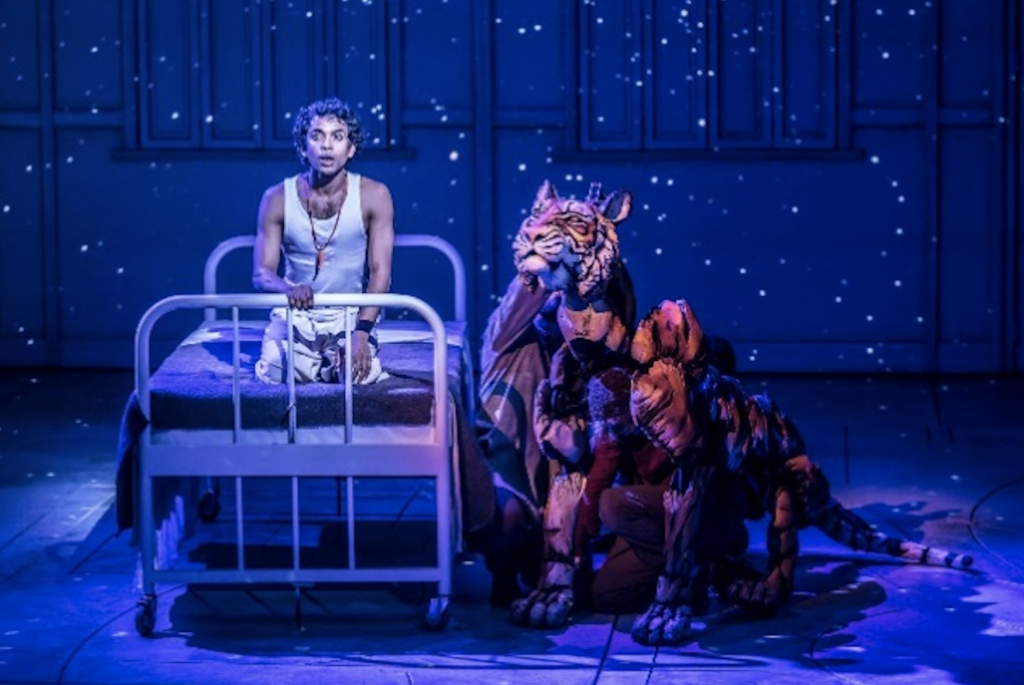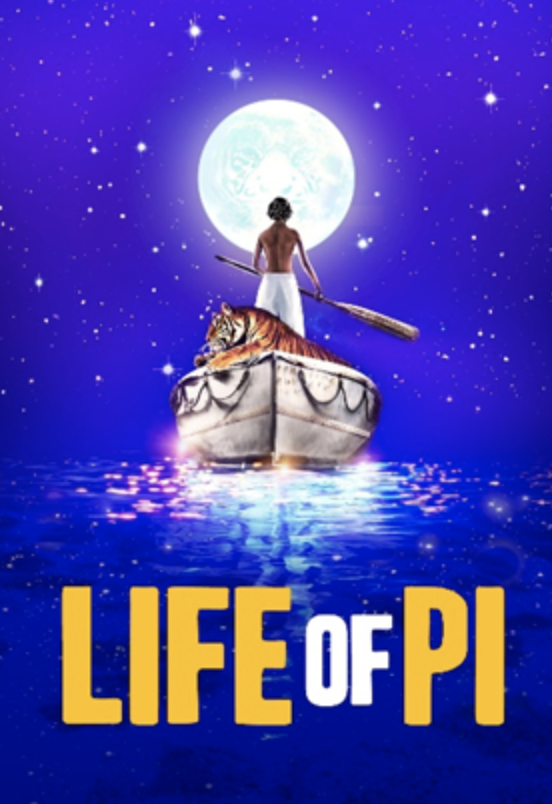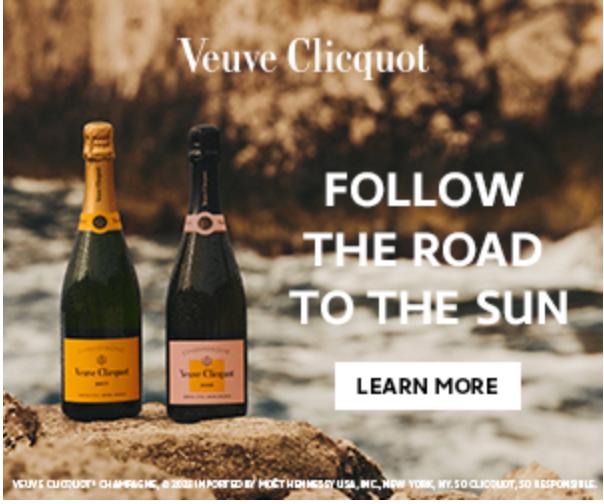LIFE OF PI Begins Broadway Performances on Thurs March 9
Preview performances of Lolita Chakrabarti’s dazzling stage adaption of Yann Martel’s best-selling novel LIFE OF PI begin Thursday, March 9, at Broadway’s Gerald Schoenfeld Theatre (236 West 45th Street).
You can enter the LIFE OF PI digital lottery the day before the performance at rush.telecharge.com.

The digital lottery opens at 12am (ET) at rush.telecharge.com one day before the performance with winners announced that same morning at 10am (ET), with a second announcement of additional winners that afternoon at 3pm (ET). Winners may buy up to two tickets at $45 each (inclusive of $5 service fee), subject to availability.
A limited number of in-person LIFE OF PI rush tickets will be available on the day of each performance for $40 per ticket when the Schoenfeld Theatre box office opens. Maximum of two tickets per person, subject to availability. The box office opens Tuesday through Saturday at 10am (ET) and Sunday at 12pm (ET).
Tickets for LIFE OF PI on Broadway are available at Telecharge.com (212.239.6200) and at the Gerald Schoenfeld Theatre box office and range from $49 – $199 (including $2 facility fee).
The playing schedule for LIFE OF PI is as follows: Tuesday through Saturday at 8pm, with matinees Wednesday and Saturday at 2pm, and Sunday at 3pm. Please note there will be no 2pm performance on Wednesday, March 15, and March 22.
Beginning Tuesday, April 4, 2023, the LIFE OF PI performance schedule is as follows: Tuesday and Thursday at 7pm, Wednesday and Friday at 7:30pm, and Saturday at 8pm, with matinees Wednesday and Saturday at 2pm, and Sunday at 3pm.
The Olivier Award-winning play LIFE OF PI will premiere at Broadway’s Gerald Schoenfeld Theatre (236 West 45th Street) with three Olivier Award-winning performers making their Broadway debuts.
Recreating their critically acclaimed performances for Broadway will be “Best Actor” winner Hiran Abeysekera in the role of “Pi” and “Best Supporting Actor” winners Fred Davis and Scarlet Wilderink join the “Richard Parker” puppeteering team. The Broadway production of the five-time Olivier Award-winning London production of LIFE OF PI also features Brian Thomas Abraham as Cook/Voice of “Richard Parker,” Rajesh Bose as Father, Avery Glymph as Father Martin/Russian Sailor/Admiral Jackson, Mahira Kakkar as Nurse/Amma/Orange Juice, Kirstin Louie as Lulu Chen, Salma Qarnain as Mrs. Biology Kumar/Zaida Khan, Sathya Sridharan as Mamaji/Pandit-Ji,Daisuke Tsuji as Mr. Okamoto/Captain, Sonya Venugopal as Rani, with Nikki Calonge, Fred Davis, Rowan Ian Seamus Magee, Jonathan David Martin, Betsy Rosen, Celia Mei Rubin, Scarlet Wilderink and Andrew Wilson as Royal Bengal tiger “Richard Parker.” Mahnaz Damania, Jon Hoche, Usman Ali Mughal, Uma Paranjpe and David Shih round out the 24-member cast with Adi Dixit as the “Pi” alternate.
LIFE OF PI begins performances Thursday, March 9, 2023, and opens Thursday, March 30, 2023. Prior to the Broadway engagement, LIFE OF PImade its North American Premiere at the American Repertory Theater at Harvard University.
LIFE OF PI is directed by Max Webster, with Set and Costume design by Olivier Award winner Tim Hatley, Puppetry and Movement Direction by Olivier Award winner Finn Caldwell, Puppet Design by Olivier Award winners Nick Barnes and Finn Caldwell, Video Design by Olivier Award winnerAndrzej Goulding, Lighting Design by Olivier Award winner Tim Lutkin, Sound Design by Carolyn Downing, Original Music by Andrew T Mackay, Dramaturgy by Jack Bradley, Wig Design by David Brian Brown, and Casting by Stewart/Whitley.
Based on one of the best-loved works of fiction – winner of the Man Booker Prize, selling over fifteen million copies worldwide – LIFE OF PI is a breath-taking new theatrical adaptation of an epic journey of endurance and hope.
After a cargo ship sinks in the middle of the vast Pacific Ocean, a sixteen-year-old boy name Pi is stranded on a lifeboat with four other survivors – a hyena, a zebra, an orangutan, and a 450-pound Royal Bengal tiger. Time is against them, nature is harsh, who will survive?
LIFE OF PI on Broadway is produced by Simon Friend, Daryl Roth, Hal Luftig, Mark Gordon Pictures, Playing Field, Tulchin Bartner Productions, Gavin Kalin, Hunter Arnold, Hall Smalberg Winkler, 42nd.club, Elizabeth Armstrong, Eilene Davidson, deRoy Shea Waxman, Federman Jenen Productions, Susan Gallin, Independent Presenters Network, John Gore Organization, Kuhn Dodani, Harriet Newman Leve, Anastasia Muravyeva, Mary Lu Roffe, Catherine Schreiber, American Repertory Theatre and Sheffield Theatres, with Aaron Lustbader and Hanna Osmolska serving as Executive Producers.
LIFE OF PI played Wyndham’s Theatre in London’s West End where it won five Olivier Awards including Best New Play, Best Scenic Design and Best Lighting Design. In an historic first for the Olivier Awards, the seven performers who play Royal Bengal tiger “Richard Parker” were collectively awarded “Best Actor in a Supporting Role.” The London production with its cutting-edge visual effects has garnered great critical acclaim and will launch a UK & Ireland tour in the summer of 2023.
@lifeofpibway on Instagram, Twitter, and Facebook



